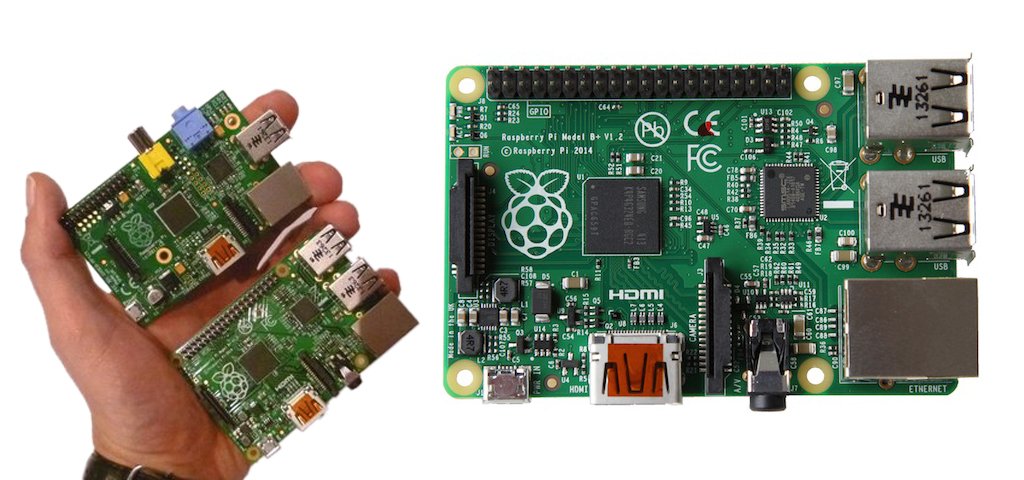The new devil
There’s a new sweet devil out for tech savvies, the new Raspberry Pi Model B+. It’s been two years after the Raspberry Pi Model B came out and millions of people had a taste of it. Since then, the community has gone far too long playing with it. There is always scope for improvement in any product and now the Raspberry Pi Foundation has come up with a new final revision of it. The spec is almost same but shaken vigorously to get a new look, that includes re-positioning connectors, adding more GPIO pins, more USB ports, changing to microSD slot, improved audio, lowering the power consumption and there have been a number of important improvements across various parts of the board. However, it still has the same CPU, SoC, Graphics and memory.
This isn’t a “Raspberry Pi 2″, but rather the final evolution of the original Raspberry Pi. $35 – it’s still the same price, of what we’re calling the Raspberry Pi Model B+. We’ll be keeping Model B in production for as long as there’s demand for it. – The Raspberry Pi foundation blogged.
A notable omission is Composite RCA video connector but, Composite video is still available through Audio-Video Combo Socket. This model also has 40 pins GPIO header instead of 26 and has a new digital signal processor for better audio performance.
The B+ also takes microSD cards instead of standard SDs. The new slot also has a push-push feel to it meaning it should behave more like the SD and microSD slots on other devices. Apart from adding more ports, the Raspberry Pi Foundation was able to reduce power consumption on the B+, and the audio circuit now has its own power supply to reduce noise. Finally, the model B+ has a new form factor and component layout that includes some fancy rounded corners. The form factor, now offering dimensions of 85 x 56 x 17mm compared to the model B’s 85.6 x 53.98 x 17mm. Be sure that you’ve new suitable case for as old cases won’t fit, while some daughter boards may also won’t fit properly.
Hardware
The Model B+ uses the same BCM2835 application processor as the Model B. It runs the same software, and still has 512MB RAM; but they have made the following key improvements:
- More GPIO. The GPIO header has grown to 40 pins, while retaining the same pin out for the first 26 pins as the Model B.
- More USB. We now have 4 USB 2.0 ports, compared to 2 on the Model B, and better hot plug and over-current behavior.
- Micro SD. The old friction-fit SD card socket has been replaced with a much nicer push-push micro SD version.
- Lower power consumption. By replacing linear regulators with switching ones we’ve reduced power consumption by between 0.5W and 1W.
- Better audio. The audio circuit incorporates a dedicated low-noise power supply.
- Neater form factor. USB connectors are aligned with the board edge, moved composite video onto the 3.5mm jack, and added four squarely-placed mounting holes.
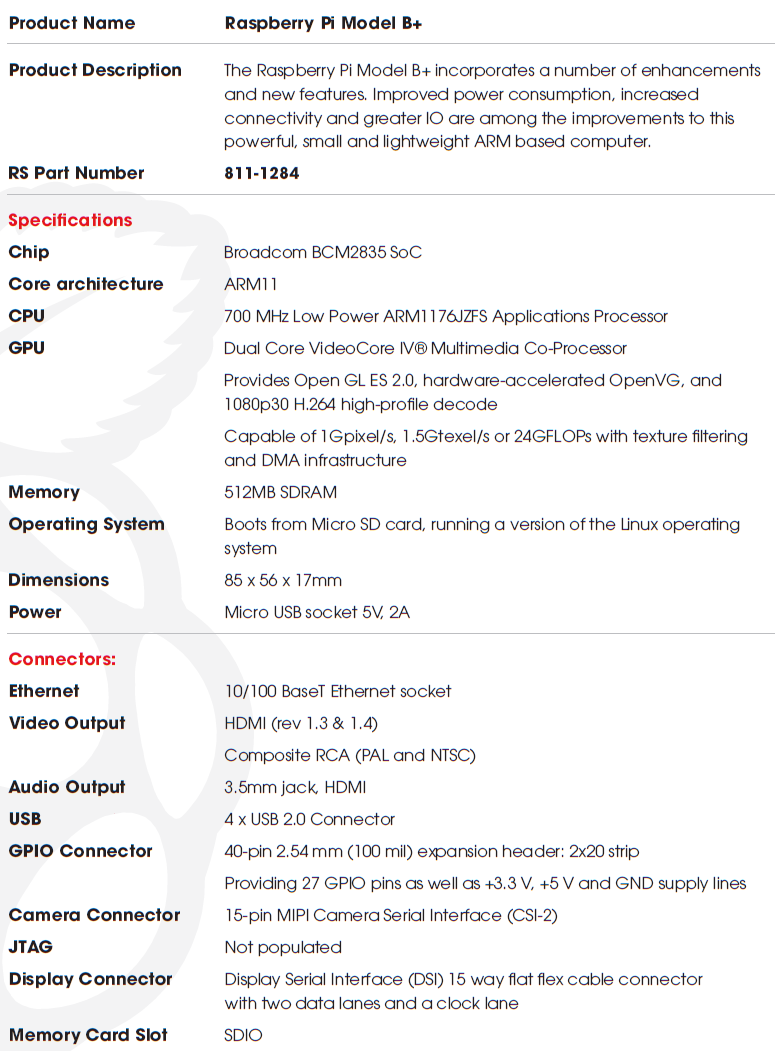
The B+ measures 85 x 56 x 17mm in size, slightly smaller than the original form factor. With this size reduction comes an improved layout and organisation of the board and looking around the board there are a number of changes present.
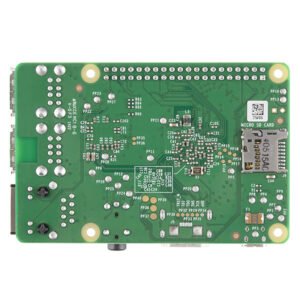
If you’re interested in precise measurements, or want to find out what the new GPIO does, check out the diagrams below.

Ports
Most noticeable change is the layout of the ports. Instead of being dotted around the perimeter of the board, as in previous models, the Model B+ only has ports on two sides of the board. With this new layout comes a few improvements, noticeably the increase of USB ports present, courtesy of the new LAN9514 chip as opposed to the older LAN9512 used on previous models.
By doubling the number of USB ports to 4 the Model B+ can have more devices attached including external hard drives thanks to the ports supporting a higher current, enough for most portable USB2 hard drives. Hot swapping of USB devices is now more stable, a very welcome addition for those that encountered the USB reboot issue present on previous models.
The Audio and Video sockets are now combined in a single 4pole 3.5mm socket. You may need an adaptor to connect your TV’s RCA video jack.
The Ethernet port remains the same as the Model B, running at 10/100. But you will now see that the USB and Ethernet ports are now level on the board, which will be great news for case manufacturers.
Moving over the HDMI port, the last port is the micro USB rated for 5V 2A which is connected to a much improved power circuit enabling greater power efficiency, a welcome addition for those using their Pi for robotics where batteries are the norm. The power circuit also provides a greater tolerance for cheaper, under powered power supplies.
For the upcoming official Raspberry Pi touchscreen display and the existing Pi Camera there are the same DSI and CSI ports, but they are now helpfully labelled DISPLAY and CAMERA.
The previous Model A and B Raspberry Pi came with a 26 pin GPIO, but the Model B+ comes with a larger GPIO (General Purpose Input Output). Now sporting 40 pins of which 26 can be used by the user, and there are 3 extra GND pins and 9 more GPIO pins. By ordering the pins in the same manner as previous Models the Model B+ can be used with the majority of the add-on boards currently on the market.
USB
The most obvious improvement in the B+ is the addition of two more USB 2 ports, bringing the total up to four. Without the improved regulator, these wouldn’t have been very useful since there wouldn’t have been enough power to run many peripherals. You can populate it with a mouse, keyboard, webcam, microphone, Wi-Fi dongle and memory stick or so on.
The B+ has four USB ports, while the B only has 2.
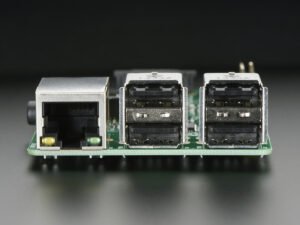
GPIO Header
After the additional USB ports, the most noticeable thing on the B+ is the additional GPIO headers. There are now 40 rather than 26 (there are actually 34 on the B, but the 8 on pad 5 don’t have headers). These provide 19 GPIOs (including pad 5) on the B and 26 on the B+. In technical terms, the whole of Bank 0 from the SoC is now exposed and the other banks are put to work elsewhere. The first 20 of the 40 headers on the B+ are the same as the B, so some existing expansion boards should work without problems. However, because the board layout has changed, larger expansion boards that fit around the components may not fit on anymore.

The additional 7 GPIOs probably won’t have much effect on most projects since expansion boards tend to use one of the GPIO communications protocol (i2C or SPI) and these only use a few pins. If you need more GPIOs, it’s fairly trivial to use one of these protocols to drive more, and this will provide some protection for the pins on the Raspberry Pi as well. There are also no more feature pins in the GPIO, so don’t expect any more PWMs or UARTs.
One area where the extra pins could come in useful is in implementing communication protocols that need more channels. For example, the model B doesn’t have enough pins to run either DPI or SLI (protocols to communicate with displays), but the B+ does. This won’t actually be supported by the Raspberry Pi Foundation, but will, in theory, be possible should someone implement it. Hopefully we’ll see some interesting expansion boards that take advantage of the new possibilities soon.

Audio
There is a 3.5mm headphone connector which on the original Raspberry Pi provided audio output only. But for the Model B+ this connector also supplies video in place of the now missing composite RCA socket, this is thanks to it now boasting 4 poles. To use this new port with your Composite connected TV you will need to purchase an adaptor. Analogue audio output has been vastly improved for the Model B+ as in the previous Models this was a little under developed. The model B had no problem processing the digital sound, however the digital-to-analogue converter (DAC) was prone to adding noise into the output that wasn’t supposed to be there.
The reason for this is that on the model B, there was a 3.3 volt supply that powered several components on the board, one of which was the DAC. If one of the other components drew current from the 3.3 volt line while sound was playing, it could cause the power supply to fluctuate slightly, and this fluctuation caused distortion to the analogue output.
On the B+, the DAC has its own power supply from the new regulator, which means there’s nothing else to make the current fluctuate and therefore the sound output is much better. There are also some other minor changes to the audio processing to make it perform better. Serious audiophiles may still want additional audio hardware, but the Pi’s sound output should now be good enough for most people.
The audio output jack on the model B+

Storage
The Model A and B Pi have all used SD cards as their data storage device, but in a smart move by the Foundation they have replaced standard SD with a rather robust and tactile Micro SD slot with a push locking mechanism. With the cost of Micro SD cards coming down in recent years this gives the end user a cheap, plentiful source of cards with full compatibility with all Models of Raspberry Pi. Perhaps the biggest of the little changes is the SD card switching from full size to micro. As well as being smaller, the new card holder feels more secure. Note that the microSD card holder is push-push type, which means you’ve push the card to lock in and push it again to remove (don’t try to pull it out).
The model B+ uses micro SD cards.

Power
Many of the improvements are to an often-overlooked part of the computer, the regulator. The Raspberry Pi gets power from a micro USB port that should supply 5V. Different parts of the Pi use different voltages, so it needs some component to reduce this 5 volts down to the different levels needed. That’s the job of the regulator. The original Pi used a linear regulator. This is a simple component that reduces a voltage, and any difference between the input voltage and output voltage is converted to heat and wasted.
The model B+ uses a switching regulator. This is a slightly more complex component that converts all the input power into output power, and only wastes a small amount. In other words, the power supply on the model B was very inefficient, and this has been fixed. The difference, according to the Pi foundation is between 0.5 and 1 watt. This isn’t going to make much of a dent in your electricity bills, but it is very important if you power up your Pi from Battery.
Different USB power supplies provide different amounts of power. Usually, it’s somewhere around 5 watts. The exact power requirements of the Raspberry Pi depend on what you’re doing, but light use of the Pi is around 3.5 watts (it can be lower if you’re really trying to squeeze efficiency out of it). This increases significantly with more things plugged in, particularly USB peripherals (unless you’re using a powered hub). In practice, we’ve found that when using most power supplies, the model B becomes quite unstable if more than two USB devices are plugged in via an unpowered hub since this can result in a power draw more than the power supply can handle. With bad power supplies, even a keyboard and optical mouse are enough to trouble it. The 0.5 – 1 watt saving can be thought as extra head room for the device, and should make it far less prone to power-related crashes.
Previously, we’ve always thought of a powered USB hub as essential for everyday use of the Pi (although you can get away without it for light use, we’ve lost too much data due to power-related crashes to recommend it). With the B+, we now view the powered hub as only necessary if you’re using high-powered USB devices. Since powered hubs are often almost as expensive as the Pi itself, this knocks off a significant proportion of the total cost of a Pi setup.
A more obvious advantage of the lower power consumption is for portable devices. There are loads of battery powered applications for the Pi.
Touch ups
There are now four mounting holes, and they’re in a rectangle which makes them a little more useful. The USB ports no longer overhang the PCB by much (it’s now the same as the Ethernet), which should make it a little easier to make cases for the board, or fit it inside embedded devices.
The board also gets a few aesthetic improvements. It now has rounded corners, and more importantly, most of the connectors are now marked. The camera and (as yet unused) display connector are labelled. It’s a minor improvement that will make it a little easier for newcomers. The Raspberry Pi now only has two status LEDs and the Ethernet LEDs have been moved to the port.

The final verdict
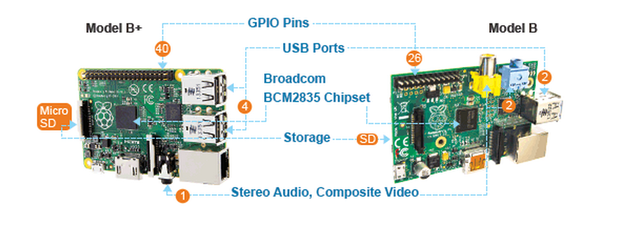
If you’re set up with a model B and everything works fine for you, then there’s really no need to upgrade, unless you are particularly interested in audio or lowering your power consumption. However, if you’re getting a new Pi, the B+ really is a much better computer. Model B’s will continue to be available, but these are really only useful for people who have designed hardware that won’t fit with the new Pi.
Anyone using the Raspberry Pi for a quick media center or playtime PC will welcome the two extra USB 2.0 ports on the B+ bringing the total to four. That’s right: This revision eliminates the need for a USB hub just to use a mouse, keyboard, Wi-Fi dongle, and USB thumb drive at the same time. Another import feature is the new switch mode regulator. To be able to handle lots more input and output means this is a significantly more useful computer, and will be especially important for new users who may not have a great power supply or a powered USB hub.
The B+ is a refined and well thought out product, it expands the firm foundation of the previous Raspberry Pi models and provides a great middle ground between the 26 GPIO pins of the Model A and B and the 120 pins of the Compute module. The B+ covers many project types and provides everything that advanced users will need for their makes.
For any aspiring computer designers out there, this is a real lesson in the fact that computer performance is about more than just CPU, memory and storage. The manner in which you connect them has a huge influence on the final product.
This model comes out almost two and a half years after the first Pi, yet it still uses the same CPU and memory. Keeping the price in parity with the Model B is fantastic and enables informed purchases to be made with ease.
The B+ is available from many of the regular Raspberry Pi stockists. You’ll find it at in.element14.com here.


